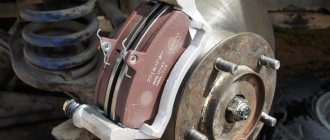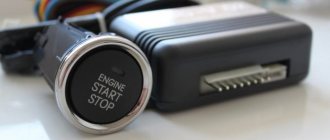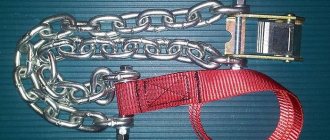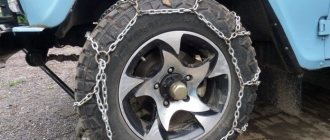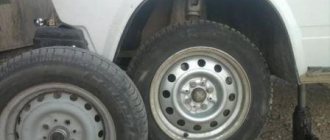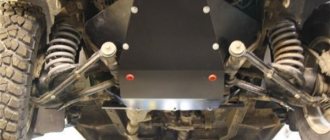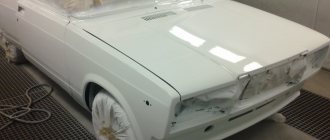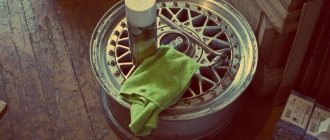As usual, new interesting notes regularly appear on the pages of my blog that relate to everything related to cars, as well as other useful information for drivers.
We have already paid attention to polishing work: this includes polishing headlights at home and making your own polish, since it is desirable to maintain the body and other exterior elements in an attractive condition. An equally important role in creating an impression is played by car tires and rims.
Grinding Methods
Before you start polishing, you must, of course, get rid of all the flaws on the discs, and this can only be done by grinding using abrasive materials.
The most popular among car enthusiasts is the diamond groove offered by tire services that use special high-precision equipment with program control that ensures high quality of work performed.
You can polish the discs yourself. Doing this manually is very labor-intensive, so everyone tries to use improvised tools that can rotate attachments with sandpaper: electric drills, pneumatic tools, etc.
To speed up the grinding process, some talented people assemble special machines that can rotate disks fixed in them and, during the rotation process, grind them using a drill. This speeds up the work significantly.
To impart rotation, many people use their own car - jack up the wheels, put the car on jacks, turn on the engine and grind the discs as they rotate.
How do specialists polish car parts?
It is not always possible to achieve the desired results with your own hands. Many people decide to turn to specialists to get the optimal appearance of their car. Today, more and more services are appearing that can perform full sandblasting, correct processing of a painted wheel, and other important tasks. Professional polishing of discs is carried out as follows:
car parts go through stages of cleaning up to sandblasting, the metal base is exposed;
Next, the surface quality is assessed and a decision is made on possible processing methods;
Using special tools, damaged areas are treated and the surface is leveled;
in a special container, the metal is polished using special minerals and vibration;
Next, the disc is opened with chemical solutions that help achieve the desired visual effect.
https://youtube.com/watch?v=RHE4QYd9jkM
This is how the wheels of your car go through several important stages. If all tasks are completed efficiently, the products look better than in the store. Sometimes, with obvious surface defects, mirror polishing is not possible. In this case, painting can be done. A popular solution is to give the wheel the color of the car body, but there is quite a lot of room for creativity here. After high-quality painting, polishing is also carried out to give the wheel the necessary shine and the desired surface texture.
What you need for polishing
To protect them from the effects of precipitation, all discs are coated under production conditions with protective paints or varnishes, which, after drying, acquire strength equivalent to the hardness of metal. Removing the coating by stripping is a very labor-intensive task, so special removers for paint and varnish are used.
In addition to the paint cleaning agent and the above tools, and polishing machines, you will need:
- attachments for grinding and polishing,
- sandpaper of different grits from P240 to P1200,
- GOI paste of different grain sizes,
- polish,
- protective varnish,
- fabric and rubber gloves,
- respirator or gas mask.
Kits for adding shine to wheels
To polish car wheels at home, the car owner must have on hand a certain set of tools and consumables, as well as special substances with which the entire process is carried out step by step.
This set typically includes the following items:
- Ideally, have a wheel polishing machine that is used by professionals at service stations. This device is a centrifuge with a rotating axis on which a wheel is attached, after which it is set in motion. In parallel with the rapid controlled rotation of the product on the machine, the master presses the abrasive on it, resulting in processing.
- If the machine is not at hand, it can be replaced with a regular drill with a circular attachment, which is often used for sanding wooden surfaces.
- The driver may also need a high-pressure apparatus used for car washing, as it effectively washes away any dirt and oil deposits on the surface of the wheel.
- Naturally, a connection to tap water and the availability of various detergents are required to completely clean the disk before exposure to the paste.
- It is necessary to purchase the main substance for surface treatment - this is a paste, and the better quality it is, the better the result will be.
- For the procedure, you will need to stock up in advance on wheels with different degrees of grain size - coarse abrasive, medium and polishing porous substance.
- In some cases, during intensive work, a spatula may be required to apply the paste to the surface of the wheel.
Polishing discs with your own hands
Important!
When purchasing all the specified tools in this set, you should not skimp on either paste or abrasive wheels, since they provide the entire result and must be of high quality, new and without containing substances harmful to the paintwork.
How to polish wheels yourself
The disassembled discs are cleaned of dirt, the paintwork is removed with a wash and the degree of their damage is determined.
It should be noted that such solvents are very toxic and you need to work with them outside or in a well-ventilated area, protecting your hands with rubber gloves and wearing a respirator. After removing the paint, the discs must be washed with water.
Depending on how deep the scratches are on the discs, the sandpaper grit is selected - for minor damage, P1000 is also suitable.
Many car enthusiasts found grinding using their car to be the simplest and most effective method. Having installed the disk on the axle of the raised car and turning on the engine in 4th-5th gear, grind it while rotating, applying sandpaper to it. It is necessary to take into account that the disc will heat up, so the abrasive will need to be periodically dipped in water.
As you remove deep scratches, you need to switch to abrasives with a smaller grain size, and before doing this, carefully clean the disc with a cloth from dust and remnants of the previous sandpaper - this will prevent the appearance of new scratches. The result of the work of smaller grains should be the removal of grooves from large ones. During the grinding process, 3-4 such transitions will be needed. You should not overdo it with sanding, especially when using coarse sandpaper, otherwise you can change the profile of the disc.
Since during this work a significant amount of powdery dust is formed, consisting of metal particles and sand, it is necessary to think about personal safety measures: work only with gloves, safety glasses and a respirator.
After removing the scratches, you can proceed directly to polishing. If the machine will continue to be used, the engine must be switched to 3rd gear. Next, apply GOI paste to a piece of felt and rub it into the surface of the disk. Since it is very thick, it is preheated or dissolved in gasoline.
You need to start, as when polishing, with a coarse-grained paste and, as the color changes during the polishing process, switch to a fine-grained paste (they differ in color - the fine-grained one is darker). The result of this work should be a mirror-like shine of the disks. It ends by removing any remaining product with a clean cloth. To preserve the results of your work for a long time, the discs must be coated with a protective polish, or even better, a protective varnish, which has a longer shelf life.
Let's start polishing
Polishing is carried out with the same device used to polish the disc. Only the nozzles, which should be soft, are changed. Some of the high-quality attachments are woolen, felt, and fabric for hard-to-reach places. All these attachments are sold both at the initial stages of polishing and at the finishing stage.
One of my favorite pastes is GOI. When choosing a paste, it is very easy to distinguish it; the thinner the paste, the darker it is. But for polishing discs, dark green and light green pastes are used.
Important to remember:
• Rub GOI paste into the surface until it changes color
• If black streaks appear due to overheating, then all the paste must be removed and started over.
• When starting final polishing, be sure to wipe the attachment with a cloth.
• Heat or dilute the paste in kerosene for better effect and savings.
Apply GOI paste to the circle and slowly spray it over the entire surface. Over time, it will be noticeable that the surface becomes mirror clean. After polishing, be sure to wipe the wheel rim with a dry cloth to remove excess paste. To better protect metal from corrosion and other influences, we use a polish with a protective effect for metals.
After polishing, wipe the entire surface of the wheel dry and apply a clear coat to prevent dulling and scratches. If your hands grow exactly from where they should, then all polished wheels will serve you for a long time.
Polishing discs with your own hands: thematic video instructions
Share information with friends:
Preparatory work
Polishing the car and wheels separately should be carried out in a ventilated place with good lighting. To make all work easier, remove the rims from the car. This will allow you to easily move them around the room and place them in a comfortable position. Next, prepare the following tools:
- Protective equipment (goggles, gloves, respirator). It is expected to work with chemicals, contact of which with skin and eyes is not recommended. During sanding work, fine dust will be generated. A respirator will protect your airways from it.
- Special means for washing. Necessary for removing old paintwork.
- Grinding tool. A drill with special attachments or a professional grinding machine. In rare cases, sanding paper P240, P400, P600, P1200 is used.
- Felt, rag, felt nozzles for polishing.
- GOI paste, polish.
Having collected the necessary equipment, get to work.
Should you polish your wheels in winter?
Winter is the worst time for metal car parts, especially wheels. After all, it is at this time of year that negative factors occur:
- On the roads there is an aggressive environment - reagents, ice, snow, slush, sand, gravel, etc.;
- Sudden temperature changes.
The biggest problem is oxide contamination - this is a product of friction and breakdown of the brake pad mixture (ferodo) on the brake discs.
You should not use acidic compounds when cleaning discs - the paint will peel off and disc oxide will form, and then rust itself may appear.
There are innovative methods on the market, in particular, ceramic molecular compounds - nanoceramics or liquid glass, based on silicon dioxide SiO2. If the application technology and curing methods are followed correctly, this will become a reliable protective method for your polished wheels in winter.
This polishing will reliably protect:
- From low temperatures;
- Corrosion;
- Ultraviolet.
It will also facilitate further cleaning of the discs and their chemical resistance to reagents. The wheels will withstand aggressive environments without losing their visual appeal.
Of course, for this application you need to contact specialists - preferably professional detailing centers.
There, the master will cover both the front part of the discs and its inner surface using the spray method, then they will carry out the polymerization (baking) process under infrared drying. After such procedures, you will see updated panels - there will be no trace of any previous defects or scratches.
After that, easy care of the discs is guaranteed. Even in a contactless wash, under the pressure of water, dirt will disappear, and the glossy shine will reappear. After all, any dirt will no longer be able to eat into the discs and come into contact with metal molecules, as it was before.
In winter, it’s time to think about preventive measures in order to preserve the original appearance of your discs for a long time. After all, applying a protective coating will cost you much less than buying new alloy wheels.
Effective wheel protection in the form of polishing is an integral part of car care. It will serve as a guarantee of safe operation of the vehicle, will allow you to feel confident during long journeys and will provide significant savings on the purchase of new wheels.
Recommendations for getting your disks in order
Pay attention to the following tips to help you perform the polishing procedure most effectively:
- purchase a special kit designed for such work;
- in the process of switching to a finer abrasive material (for example, sandpaper), remove all debris accumulated there from the metal surface;
- when cleaning, a powder will certainly form based on abrasive grains and metal particles - it must be brushed off so as not to cause scratches on the surface;
- stop work more often and carry out a visual inspection so as not to remove excess material;
- Make sure that the disk does not overheat, and therefore work at low speeds.
Types and features of disks
Before getting started, you need to find out what type of polish is suitable for your wheels. Yes, different elements are polished in different ways, and for good reason.
First, let's find out what types of car wheels there are:
- Stamped discs.
The most famous type of wheels among motorists. This is due to the fact that most often cars with them go out of production, plus they are considered indestructible - if damaged (most likely, these are dents), they can be easily repaired. Drivers are not particularly eager to change them for others. And the affordable price of around 1,500 rubles warms the soul.Compared to competitors, stamped wheels are made of steel and are heavy. And they don’t please with the variety of designs. Owners solve this problem with the help of caps, whose task is precisely to decorate the car.
- Cast.
Alloy wheels are made from aluminum compounds, so they are quite lightweight. In addition, aluminum allows you to create interesting shapes, which significantly improves the appearance of the car. Another plus is that alloy wheels are capable of conducting heat, and therefore are used to remove excess temperature from the brakes.If we talk about the disadvantages, we can note the price – about 4000-5000 rubles. Also, if you drive carelessly, they can break, and they cannot be restored, only replacement - this can cost a pretty penny. You should be especially careful. But, despite the disadvantages, alloy wheels are popular among motorists.
- Forged.
This type is lightweight, highly durable and resistant to damage. But this coin also has a downside - due to their strength, if they fall into a pothole or hole, the load will go to the suspension mechanisms, which may not withstand it. The design of forged wheels is also sparse, but the price remains an order of magnitude higher than that of stamped wheels - at least 3,000 rubles.Now that we’ve figured out what types of discs there are, let’s find out how each type can be polished yourself.
Precautions and Tips
Any human activity, if not handled carefully, can cause a lot of trouble. To prevent this, take care to ensure health safety and perform the job correctly.
- Before you start polishing, take care to protect your skin: wear gloves and a mask that covers your face, because most polishes and varnish for aluminum wheels are toxic;
- You should not use maximum effort to remove defects. Light pressure on the polishing cloth is enough;
- Do not allow the surface to overheat - grinding the discs is carried out at a slow pace by hand and at low speeds when using a grinding machine;
- Before purchasing a polish, make sure that it does not contain anhydrous ammonia or acids. If they are present, the use of polish will lead to corrosion;
- If it is not possible to remove the wheels, it is better to polish them manually so as not to touch the machine on any foreign surface of the car.
In addition, there are little tricks that will simplify the work.
- Polishing discs to a mirror shine with your own hands will go faster if, using GOI paste, you heat it up or dilute it in kerosene;
- Don't have a sander? No problem - use an ordinary drill at low speeds;
- Deep scratches can be removed with a file, and marks from the curb can be cut off with a grinder;
- Do-it-yourself grinding of brake discs in hard-to-reach places will go faster when done by hand, and to get into grooves or threads that cannot be polished with a machine, use a toothbrush with a polishing cloth wrapped around it;
- Instead of polish, buy regular toothpaste;
- Primer treatment will serve as an additional protective layer;
- The varnish will lay down in an even layer if you spray it from the can in a circular motion;
- Weekly washing of discs with special protective shampoos will help maintain the polishing effect;
The mirror polishing of the discs is complete. Now admire the reflection of puddles in the shiny surface and don’t be afraid of possible damage on the road. Remember to repeat the procedure every season or every 6 months.
Source krasimavtomobil.ru
How to give your car's rims a mirror look without buying new ones? With the help of polishing, of course!
But we want to warn all the lazy people that this will take more than one hour, and you will need a lot of strength. So if you haven't decided to shell out for new rims yet, then be patient! After all, you will have to work with both dust from abrasives and fumes from chemical pastes and paint and varnish solvents.
Difference between grinding and polishing
Many people do not understand the difference between grinding and polishing. To see that very difference, you need to delve into the definitions themselves.
- grinding is an action that makes it possible to make the surface of a solid material smooth using abrasives;
- polishing is an action that is the final stage in the manufacture of a tool, which involves extreme smoothing of the surface until a specific shine appears.
These two operations are interconnected and follow one another.
| Grinding | Polishing |
| Done before polishing | Produced after grinding |
| The goal is to remove unnecessary | The goal is final leveling, adding shine. |
| Grinding machines are used | Polishing machines are used |
| Exclusively mechanical impact | Different types of influence |
Types of wheel polishes
Before preparing car wheels for polishing, you need to make sure that the selected polish is truly safe for metal parts. Depending on the type of wheel rims, cleaning agents are selected. There are 2 types of polish:
- Powder: contains aggressive abrasive substances that quickly remove scratches and dried dirt from discs. It is advisable to use such products when polishing old cars.
- Gel-like: forms an enveloping coating that protects wheels from corrosion and road chemicals. Ideal for polishing new cars.

